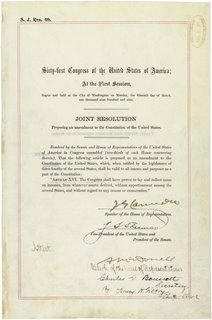A favorite topic of tort “reformers” is to place arbitrary caps on personal injury damage awards for pain and suffering. In doing so, they simply ignore the fact that caps already exist, but without the low ball one-size-fits-all numbers they argue for. In fact, we’ve been capping damages now in New York for almost 200 years without using an arbitrary number.
Here’s how it works: On occasion a jury will give an outrageous number…sometimes way too high, and sometimes way too low. (Newspapers only cover the high ones.) While jury awards are given great deference by the courts, that deference is not absolute, and the judge has the power to modify the award. Not directly, since the court won’t simply substitute its own judgment for the jury, but by tossing out the award and ordering a new trial unless the aggrieved party stipulates to the new amount chosen by the court. This happens at both the trial court level and the appellate level.
The earliest opinion I’ve seen where the court says it will not accept any award from a jury in New York is from 1812:
“It is not enough to say, that in the opinion of the court, the damages are too high and that we would have given much less. It is the judgment of the jury, and not the judgment of the court, which is to assess the damages in actions for personal torts and injuries….The damages, therefore, must be so excessive as to strike mankind, at first blush, as being beyond all measure, unreasonable and outrageous, and such as manifestly show the jury to have been actuated by passion, partiality, prejudice, or corruption. In short, the damages must be flagrantly outrageous and extravagant, or the court cannot undertake to draw the line; for they have no standard by which to ascertain the excess.” – Chief Judge James Kent, Coleman v. Southwick, 9 Johns. 45, 1812)
Chief Judge Kent’s standard of being “flagrantly outrageous and extravagant” to toss out a civil award is now read in two similar ways: The appellate court language is that the damages “deviate materially from what would be reasonable compensation”; and the trial courts say they will order a new trial when the verdict “shocks the conscience of this court.”
This methodology of ordering a new trial if the party did not stipulate to reduced damages came up in a famous 1913 case, involving future Supreme Court Justice Benjamin N. Cardozo and Bat Masterson, a legendary figure of the Old West, when a jury returned a defamation verdict in favor of Masterson for $3,500. The reason? Cardozo’s client had said that that Masterson had “made his reputation by shooting drunken Mexicans and Indians in the back.” (Hat tip to Randy Barnett at The Volokh Conspiracy.) New York’s appellate court tossed the verdict and awarded a new trial unless Masterson stipulated to a reduction of the verdict to $1,000.
And in one of my own trials, I took a $610K verdict in a Brooklyn medical malpractice case resulting from a misplaced injection that injured the sciatic nerve. The court reduced my client to $450K using the same stipulation mechanism. To see how often the New York courts continue to do that, just pop the phrase “deviate materially from what would be reasonable compensation” into the search box at the court’s appellate website here.
In other words, to persevere in an action for pain and suffering, one must first win with a jury’s review, then have that verdict pass muster before the judge that heard the case, and then have the verdict reviewed a third time in front of an appellate panel.
So why put arbitrary caps in place if common sense ones already exist? Because the movement to do so has nothing to do with finding justice, but rather, is run by big business and its front groups such as the U.S. Chamber of Commerce to give negligent conduct various forms of immunities and protections when folks are injured. The idea is to remove the concept of personal responsibility for one’s actions.
The big verdicts make big headlines. The subsequent reductions (or additions when a plaintiff is badly shortchanged) rarely appear. But simply because you don’t see it in the papers doesn’t mean it doesn’t exist.
Addendum, 3/12/07 — For more on the disparity of coverage between verdicts and subsequent reductions, see Media Bias at TortDeform.
 When cars collide head-on in New York, does at least one of them have to be negligent? A jury said no, and the trial court agreed. The case was brought by an injured passenger in one of the cars.
When cars collide head-on in New York, does at least one of them have to be negligent? A jury said no, and the trial court agreed. The case was brought by an injured passenger in one of the cars.
